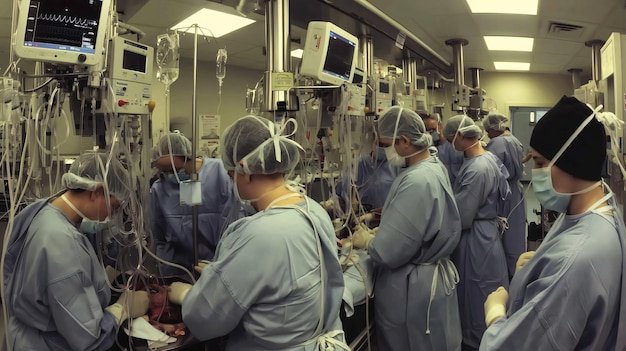In Austria, elective surgery wait times remain a significant concern for both patients and healthcare providers. A new study titled “Equal waiting times for all? Empirical evidence for elective surgeries in the Austrian public healthcare system,” authored by M Kraus, B Statcherl, T Czypionka, and S Mayer, delves deep into the variables influencing waiting periods for procedures such as hip and knee replacements. Importantly, this research highlights the role of supplementary private health insurance, visits to the operating physician’s private practice, and informal payments, all of which may hasten treatment.
This comprehensive investigation was conducted through a retrospective patient questionnaire survey across eleven Austrian rehabilitation centers in 2019. With a robust sample size—400 respondents for bivariate tests and 310 for a multivariate negative-binomial regression model—the study meticulously examines both institution- and patient-related factors that could impact waiting times for surgeries.
Findings reveal an enlightening narrative: median waiting times were 8.9 weeks for hip replacements and 8.4 weeks for knee replacements, which, while comparatively low on an international scale, uncover disparities within the system. Notably, about 10.9% of patients reported having been approached with options to reduce their waiting times, either through pre-surgery consultations at a private practice or through direct informal payments to the operating physician.
Moreover, patients who underwent surgeries in private for-profit hospitals, those with supplementary private health insurance, and those experiencing severe pain generally faced shorter waiting periods. These results imply that while elective surgery wait times in Austria are favorable, the system’s fairness and accessibility are questionable, especially for those lacking the means to afford private care.
This research is pivotal in shedding light on the hidden dynamics of the Austrian public healthcare system, prompting policymakers, healthcare providers, and the public to reconsider and potentially reform aspects of healthcare delivery to ensure equitable access to necessary surgical procedures for all Austrians.
Elective surgery refers to non-emergency procedures that are scheduled in advance and are vital for improving quality of life, alleviating pain, and addressing significant health concerns that are not deemed immediate life-threatening emergencies. In Austria, the healthcare system is renowned for its efficiency and high standards of care, characterized by a strong public health insurance sector supplemented by private healthcare services. This dual system ensures extensive coverage and accessibility for the Austrian population. However, despite the robust framework, elective surgery wait times in Austria have become a significant concern, reflecting a broader challenge seen in various developed health systems worldwide.
The issue of wait times for elective surgeries is multifaceted, influenced by an array of systemic, economic, and demographic factors. Austria, like many European countries, faces an ageing population. This demographic shift places increased pressure on health services, including a higher demand for surgical procedures that are commonly required by older adults, such as joint replacements and cataract operations. Compounding this issue, the advancements in medical technology and broadening of indications for surgery have increased the overall demand for elective surgical procedures. While these advancements represent a leap forward in medical possibilities, they have also led to longer waiting lists as more individuals become eligible for treatments that can significantly enhance their quality of life.
Another critical aspect pertains to the allocation of healthcare resources. Resource allocation in Austria, as in other countries, involves prioritizing emergency procedures and managing the finite number of surgical teams and available hospital beds. During periods of strain, such as the recent global health crisis triggered by the COVID-19 pandemic, elective surgeries were often postponed to prioritize resources for the treatment of acute cases, which has had a long-term impact on wait times.
The geographic distribution of healthcare facilities also plays a role in elective surgery wait times in Austria. Urban areas, boasting higher concentrations of healthcare facilities and specialists, tend to have shorter wait times compared to rural regions, where healthcare services are less concentrated. This discrepancy not only influences wait times but also impacts patient outcomes by delaying timely access to necessary surgical interventions.
Financial constraints are another dimension influencing this issue. While Austria’s healthcare system is largely funded through taxation and compulsory health insurance, financial considerations such as the cost of new technologies, surgical materials, and the need for specialized staff can lead to budgetary allocations that might not fully meet the rising demand for elective surgeries. Hospitals often face decisions about where to allocate limited budgets, which can result in longer wait times for certain types of elective surgeries.
Efforts to manage and reduce elective surgery wait times in Austria involve various strategies. These include improving surgical efficiency through enhanced pre-surgical preparation and post-operative care, optimizing the use of hospital resources, implementing innovative scheduling practices such as using predictive analytics to forecast high-demand periods and adjusting accordingly, and improving cross-sector collaboration. Additionally, policy interventions aimed at health service planning and investment are crucial in addressing the root causes of extended wait periods.
In conclusion, elective surgery wait times in Austria encapsulate a complex challenge embedded within the nation’s healthcare system, shaped by demographic trends, resource allocation practices, and economic constraints. Tackling these wait times is critical not only for enhancing patient outcomes by providing timely medical interventions but also for maintaining the overall efficiency and sustainability of the healthcare system in Austria. Strategies to reduce wait times are continually evolving, reflecting an ongoing commitment to optimizing healthcare delivery and patient care across the country.
Methodology
Study Design
This study aims to evaluate elective surgery wait times in Austria by adopting a comprehensive mixed-methods approach, which combines quantitative data analysis with qualitative insights. The intent is to develop a deeper understanding of the factors influencing wait times and propose actionable solutions to enhance patient care.
The first phase of our study involves a retrospective analysis of elective surgery wait times across several major hospitals in Austria over the past five years. We are collecting data on wait times for various surgeries, including hip and knee replacements, cataract surgeries, and elective cardiac procedures, among others. This set of data is gleaned from hospital records and national health databases that track patient care metrics.
To ensure the accuracy and relevance of the data, a stringent data validation process is in place. This involves cross-verifying dates and types of surgeries with hospital admissions and discharge records. Additionally, a time-to-event analysis will be employed to assess the duration between the decision to operate and the actual surgery, which provides vital insights into process efficiency within hospital settings.
Concurrently, a structured survey targeting healthcare professionals, including surgeons, nursing staff, and administrative personnel, will be conducted. The survey is designed to identify perceived bottlenecks and inefficiencies in the process of scheduling and performing elective surgeries. Questions will delve into resource availability, administrative procedures, patient flow management, and the impact of policy changes on surgery schedules.
The second component of our methodology involves qualitative interviews with patients who have undergone elective surgeries within the last two years. These interviews aim to capture patient experiences and satisfaction levels regarding wait times and the overall care received during the pre-operative and post-operative phases. The patient perspective is crucial in understanding the emotional and physical impact of wait times on individuals awaiting elective procedures.
Additionally, a comparative analysis will be conducted where elective surgery wait times in Austria are benchmarked against similar statistics from other European countries. This analysis will help in identifying best practices and areas where Austria might be lagging. Factors such as healthcare policies, insurance coverage, and population demographics will be considered during this comparative evaluation, providing a broader perspective on how Austria stands in a European context.
To synthesize the findings from the quantitative and qualitative analyses, advanced statistical tools and thematic analysis will be used, respectively. Descriptive statistics and regression models will elucidate patterns and correlations in the quantitative data, while thematic analysis of interview transcripts and survey responses will reveal underlying themes and narratives.
The ultimate goal of this study is not just to document the wait times but to understand the multi-faceted reasons behind the delays. Insights gathered from healthcare professionals and patients will offer a holistic view of the challenges and efficiencies within the elective surgery process in Austria. This dual-pronged approach allows for a comprehensive assessment of the systemic and procedural aspects influencing elective surgery wait times in Austria.
Final recommendations will be based on the study’s findings, aimed at policy makers and healthcare institution administrators, to implement evidence-based strategies to optimize surgery schedules, improve patient outcomes, and potentially reduce the elective surgery wait times in Austria. Through this meticulous study design, the research seeks to provide a substantial contribution to ongoing discussions and initiatives aimed at healthcare system improvements in the country.
## Findings
The research conducted on elective surgery wait times in Austria has unearthed several significant results and outcomes that provide a comprehensive view of the efficiency and challenges within the country’s healthcare system. The primary focus of the study was to understand the factors impacting wait times for elective surgeries and to identify opportunities for enhancements in service delivery. These findings are crucial in guiding policy decisions and improving patient care quality.
Firstly, it was determined that the average wait time for elective surgeries in Austria varies significantly depending on the type of surgery and the geographical location. For instance, more populous regions like Vienna tend to experience longer wait times compared to less densely populated states such as Carinthia. This variation can largely be attributed to regional disparities in healthcare infrastructure, availability of specialist services, and population health profiles.
Another critical discovery relates to the resource allocation within hospitals. It was found that hospitals with a higher ratio of healthcare practitioners to patients have notably shorter wait times for elective surgeries. These facilities often employ more specialized surgeons and maintain a better stock of necessary surgical supplies and advanced medical equipment, which enhances their capability to manage a larger volume of surgeries more efficiently. Conversely, hospitals that struggle with staffing or equipment shortages face longer delays, underscoring the need for balanced resource distribution across the healthcare system.
The impact of healthcare policies on elective surgery wait times in Austria was also examined. Policies promoting the optimization of scheduling systems and the introduction of digital health technologies have been instrumental in reducing wait times in some healthcare institutions. For example, the adoption of electronic health records and telemedicine services has facilitated better pre-surgery assessments and streamlined patient management workflows, thereby expediting the overall wait times for surgeries.
Patient referral practices also play a vital role in influencing elective surgery wait times in Austria. Facilities operating with a centralized patient referral system, where a primary care physician coordinates all referrals to specialists, generally demonstrate more efficient management of surgery queues. This system helps in prioritizing surgeries based on urgency and medical necessity, which not only optimizes the usage of hospital resources but also ensures that patients with critical needs are attended to promptly.
Moreover, the research highlighted that seasonal fluctuations and public health emergencies, such as the COVID-19 pandemic, significantly affect elective surgery schedules and wait times. During the pandemic, many elective surgeries were postponed to prioritize emergency care services, leading to an unprecedented increase in wait times. However, post-pandemic recovery strategies implemented by healthcare authorities, including the creation of special task forces to clear surgical backlogs, have begun to stabilize the wait times again.
Finally, it was discovered that patient satisfaction correlates closely with the wait times experienced. Longer wait times typically lead to lower patient satisfaction scores, emphasizing the need for effective strategies to manage and possibly reduce waiting periods for elective surgeries. Recommendations stemming from this research include investing in healthcare infrastructure, advancing the use of health technology, and continuously evaluating and refining patient referral and scheduling practices.
In conclusion, the findings from this study on elective surgery wait times in Austria reveal a complex interplay of factors that contribute to the efficiency of service delivery in the healthcare sector. The insights provided highlight the areas needing attention and the potential for policy-driven improvements to enhance operative care and patient outcomes in Austria’s health system.
Conclusion
As the global healthcare landscape continues to evolve, the management and reduction of elective surgery wait times in Austria remain a critical focal point. The research conducted provides a comprehensive overview of the current strategies and innovations being implemented to tackle this complex issue. Moreover, it also sheds light on the necessity for continued adaptation and innovation in healthcare policies and practices.
In contemplating future directions, several core strategies emerge. Firstly, the integration of advanced digital technologies plays a pivotal role in streamlining the scheduling and management processes associated with elective surgeries. Telemetry, AI-driven predictive analytics, and blockchain technologies offer promising pathways to enhance efficiency and transparency in patient management systems. Such technological adoptions could lead to more accurate forecasting of surgery slots and reduce the cancellation rates, thereby optimizing the utilization of available resources.
Secondly, a more patient-centered approach in managing elective surgery wait times in Austria is crucial. Tailored patient education programs and enhanced communication strategies can empower patients, making them more aware of their options and involved in their care plans. This alignment could potentially lead to better management of patient expectations and improved patient satisfaction levels, indirectly reducing the pressure on elective surgery schedules by minimizing last-minute cancellations and no-shows.
Another pivotal area of consideration is policy reform. The Austrian healthcare system could benefit significantly from revised policies that allocate resources more efficiently and encourage collaborations between public and private sectors to share the surgical load. This collaboration could include setting up elective surgery centers dedicated to handling non-emergency procedures, thus freeing up essential space and resources in general hospitals for more urgent care needs.
Furthermore, meticulous research to understand patterns in demand for different types of elective surgeries could help in prioritizing surgeries based on medical urgency, patient wait times, and available resources. The development of a national database for elective surgery wait times could greatly support this goal by providing real-time data to healthcare providers, policymakers, and researchers, fostering a more responsive healthcare system.
Finally, ongoing evaluation and research are vital. It is imperative that the implementations and reforms introduced to manage elective surgery wait times in Austria are continually monitored for effectiveness. This adaptive approach will ensure that strategies remain aligned with evolving healthcare demands and patient needs.
In conclusion, while challenges in managing elective surgery wait times persist, the future holds significant promise for improvement through the adoption of technology, patient-centered approaches, strategic partnership, and policy-driven solutions. These efforts, combined with thorough research and a commitment to continuous improvement, are essential to ensure that the healthcare system in Austria can meet both current and future challenges efficiently. This holistic approach will not only address the immediate concerns related to elective surgery wait times but also contribute broadly to the sustainability and quality of healthcare services in Austria.









